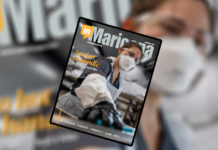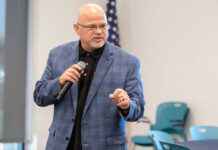
October is here, and I would like to take some time to pass on information about a very serious and important topic: breast cancer.
October is National Breast Cancer Awareness Month. I, personally, have a family member who is a 15 plus year survivor, having undergone multiple surgeries and chemotherapy treatments. There are firefighters and community members who have lost mothers, grandmothers, aunts and sisters to breast cancer.
In the past I have written articles pertaining to water safety and drowning awareness; however, I was asked to write this article because of the impact breast cancer has had on many of us here at the fire department and most likely many of you in this community. I hope this article will provide information, facts and answer some of the questions that you or a family member may have when it comes to breast cancer.
Facts and figures:
Breast cancer is the leading cause of cancer death in women between the ages of 15 and 54, and the second cause of cancer death in women 55 to 74. Breast cancer is the most frequently diagnosed cancer in women and the second leading cause of cancer death in women, after lung cancer. One out of eight women in the United States will develop breast cancer if they live past the age of 85, a risk that in 1960 was one out of 14. An estimated 180,510 new cases of invasive breast cancer are expected to occur among women in the US during 2007 (this does not take DCIS into account). About 2,030 new cases of breast cancer are expected in men. An estimated 40,910 breast cancer deaths are anticipated this year (40,460 women; 450 men). There are 2.3 million women living in the U.S. who have been diagnosed and treated for breast cancer.
Who gets breast cancer? (American Cancer Society, Cancer Facts & Figures 2006)
Anyone can get breast cancer. For example, did you know…
· The older a woman is, the more likely she is to get breast cancer?
· White women are more likely to get breast cancer than women of any other racial or ethnic group? They also have a better chance of survival, primarily because their cancer is usually detected earlier.
· African American women are more likely to die from breast cancer than white women.
· Men can get breast cancer, too, although it is rare. Less than one of every 100 cases of breast cancer in the U.S. occurs in men.
· In 2006 it was estimated that men would account for 1,720 cases of breast cancer.1
Factors that may increase your risk of breast cancer (American Cancer Society):
· Having an inherited mutation in the BRCA1 or BRCA2 breast cancer genes
· Having a previous biopsy showing hyperplasia or carcinoma in situ
· Having a mother, daughter or sister who has had breast cancer
· Having high breast density on a mammogram
· Being exposed to large amounts of radiation, such as having very frequent spinal X-rays during scoliosis treatment or treatment for Hodgkin’s
disease at a young age
· A personal history of breast or ovarian cancer
· Starting menopause after age 55
· Never having children
· Having your first child after age 30
· Being overweight after menopause or gaining weight as an adult
· Having more than one drink of alcohol per day
· Currently or recently using combined estrogen and progesterone hormone replacement therapy (HRT)
· Being young (<12 years) at the time of your first period
· Taking birth control pills for five years or longer
Age – a major factor:
A woman’s chance of getting breast cancer increases with age. Your chance by your current age is (American Cancer Society Surveillance Research, 2005):
age 20 — 1 in 1,985
age 30 — 1 in 229
age 40 — 1 in 68
age 50 — 1 in 37
age 60 — 1 in 26
age 70 — 1 in 24
over 70 — 1 in 8
Your best defense:
The best way to find breast cancer in its earliest stages is to routinely check your breasts for signs and symptoms of the disease. There are three basic methods:
Mammograms are X-ray pictures of the breast. They can find breast cancer in its earliest stages, even before a lump can be felt. All women 40 and older should have a mammogram every year. If you are younger than 40 with either a family history of breast cancer or other concerns, talk with your health care provider about when to start getting mammograms and how often to have them.
Clinical breast exam is performed by a health care provider who carefully checks your breasts and underarm areas for any lumps or changes that may be present. Many women have a clinical breast exam performed when they get their Pap test. Women should have a clinical breast exam at least every three years between the ages of 20 and 39 and every year starting at 40.
Breast self-exam (BSE) involves two main steps, looking at and feeling your breasts for any change from normal. If you notice any change in the normal look or feel of your breasts, see your health care provider. All women should perform monthly BSE by age 20. BSE should be done once a month, a few days after your period ends. If you no longer have periods, do BSE on the same day each month. At your next appointment, ask your health care provider to show you the steps for BSE.
For step-by-step BSE instructions, go to www.komen.org /bse or call 1-800 I’M AWARE (1-800-462-9273) to request a free BSE card.
Many of you have noticed the pink ribbon campaigns in the past and some that are starting up right here in Maricopa. Fry’s Marketplace, for example, is taking donations for the Susan G. Komen Foundation.
The Professional Firefighters of Maricopa, Local 4561, are also getting involved. For the first time, the members of the fire department, their families and friends are participating in the annual Race for the Cure event held in downtown Phoenix. This year’s event is October 14 and is expected to bring 40,000 plus participants and thousands more volunteers and sponsors. This event is one of many nationwide to help raise money for breast cancer research, treatment assistance, awareness of breast cancer and education on the importance of annual breast exams and personal breast exams.
The firefighters and family members participating in the Race for the Cure will be wearing a t-shirt specially designed for this event and selling them to help raise money for this great cause. All proceeds from the sale of these shirts will be donated to the Susan G. Komen Foundation; these donation dollars will stay in the State of Arizona through the local chapter of this fine organization. Any community member interested in purchasing one of these shirts can get one at the Water and Ice store located near Bashas’ on John Wayne Parkway.










![Alleged car thief released without charges Phoenix police stop a stolen vehicle on April 20, 2024. [Facebook]](https://www.inmaricopa.com/wp-content/uploads/2024/04/IMG_5040-218x150.jpg)

![3 things to know about the new city budget Vice Mayor Amber Liermann and Councilmember Eric Goettl review parts of the city's 2024 operational budget with Mayor Nancy Smith on April 24, 2024. [Monica D. Spencer]](https://www.inmaricopa.com/wp-content/uploads/2024/04/spencer-042424-preliminary-budget-meeting-web-100x70.jpg)


